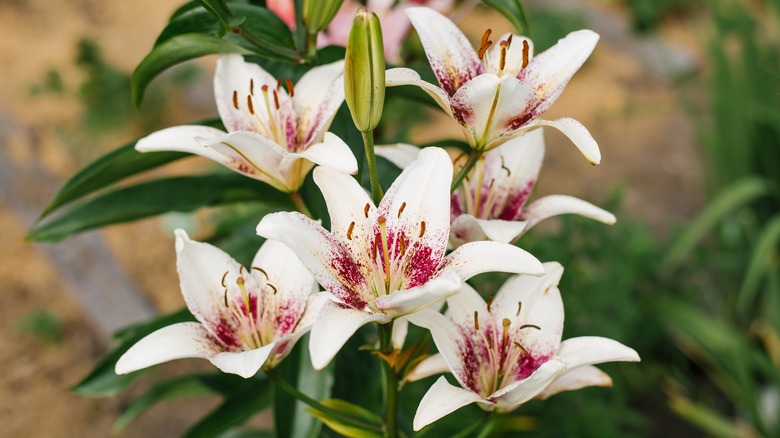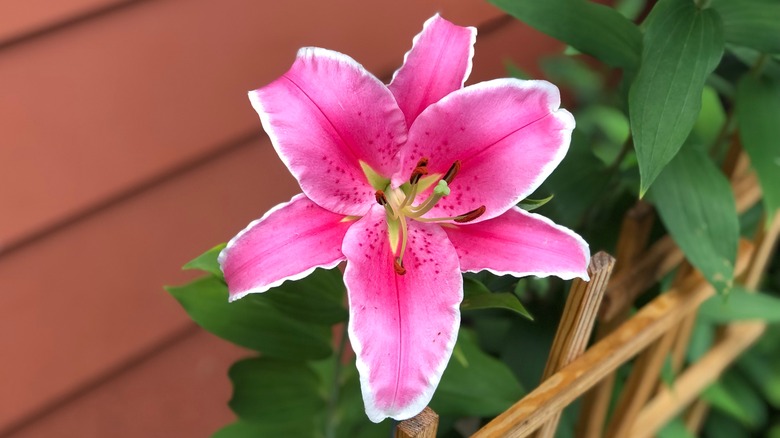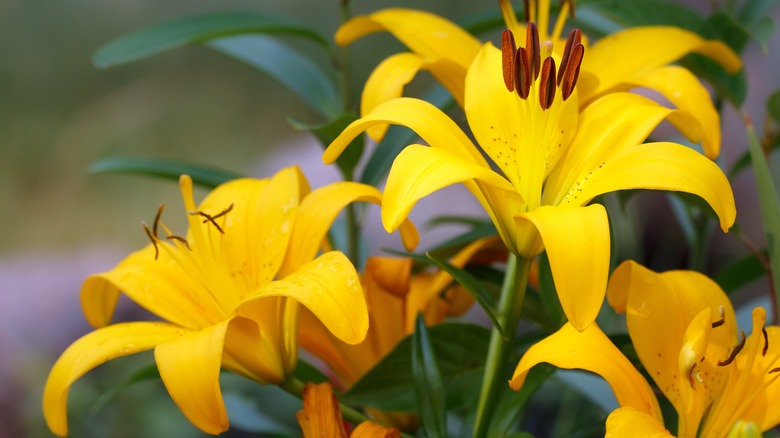Here's When To Expect Asiatic Lilies To Produce Their Stunning Blooms
Lilies are resilient, beautiful plants that are easy to grow, which makes them suitable for all gardening skill levels. It's no wonder then that they're one of the most popular summer bulbs around. Another big selling point is that there are over 80 different species to choose from, including the Asiatic lilies. They bloom early in the season, in May and June. Asiatic lilies don't have much of a fragrance and they're actually the shortest lilies around and can be as short as 2 feet, but what they lack in height and smell, they sure make up for in fullness and beauty. These perennials offer a great way to bring color to your garden, as they're available in a myriad of colors, from gold to pink and beyond. You can even choose from a long list of funky bi-color creations. What's more, Asiatic lilies have an impressively high bud count and each flower is nice and plump, measuring 4 to 6 inches on average.
Their early blooming time and longevity are a major draw for these flowers. Asiatic lilies are usually one of the very first flowers to bloom and will show off their beautiful upward-facing petals early in the season –- right after peonies. What's more, when well maintained, they'll stick around for weeks, adding pops of color to your backyard, as well as your home. Asiatic lilies are perfect for cutting and flower arranging and are sure to bring a smile to your face all season long.
Asiatic lilies' blooming cycle, explained
If you want your garden to begin blooming as soon as winter is gone, fill it with vivacious Asiatic lilies. Not only are they the earliest lily variety to bloom, but they're also one of the first flowers of any species to show off stunning buds. Asiatic lilies typically open in early to mid-summer, usually in May or June, and once they do, they like to stick around. These particular lilies can be in full bloom for up to one month and thrive in plant hardiness zones 4 to 9, meaning they do well in most of the United States, except for the very northern and southernmost areas.
In order to ensure they bloom when they're supposed to, you'll want to plant them in the fall, at least one month before any frost sets in. This way, the bulbs will have plenty of time to set down strong roots until the spring, which will help ensure stable plants that don't require staking. But if you live in an area with harsh winters and are worried about the bulbs potentially freezing and dying, you can plant them in early spring, as soon as the final frost has passed. You can dig the bulbs up each fall and plant them in the spring as soon as the threat of frost has passed. Buy your bulbs right before you plan to plant them for best results.
How to properly plant and care for Asiatic lilies
When planting Asiatic lilies, it's important to keep two things in mind: They like plenty of sun and well-drained soil. The best spot to plant them is in an area where they can enjoy 6 to 8 hours of direct sunlight each day, otherwise they may bend and even fall over in trying to twist towards the sunshine. What's more, while Asiatic lilies need a constant supply of water to thrive (1 to 2 inches per week), they'll actually rot if they're planted in waterlogged soil.
Once you've chosen the perfect area for your Asiatic lilies, make sure to plant each bulb in a hole with a depth three times the bulb's height. Always place them in the ground with their pointed side facing upwards and leave a space between bulbs that's three times their diameter. Cover them with soil, compost, and about 2 inches of mulch, then water regularly and help boost their growth with a high-potassium liquid fertilizer twice a month.
Asiatic lilies will only bloom once each season and it's important to deadhead spent flowers as soon as you notice them. However, you should never remove any leaves until they've faded and become brown, usually in the fall. At that point, you can also remove the dead stalks and cover your lily patch with 4 to 6 inches of mulch to help get it through the winter and ensure it blooms again next spring.



